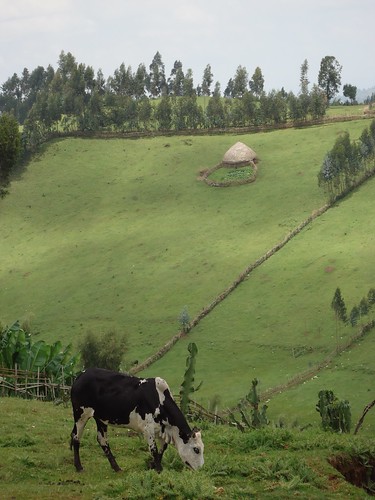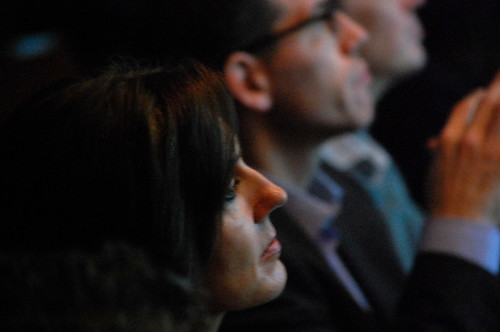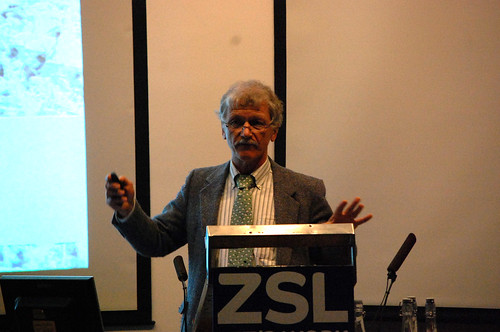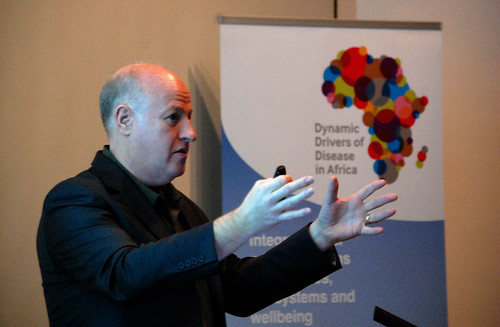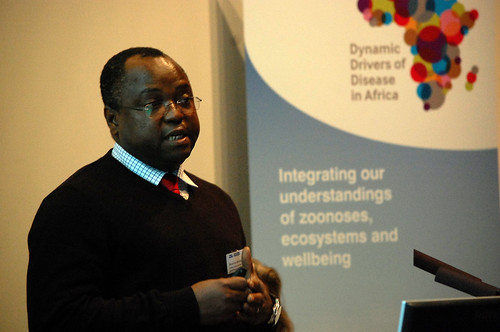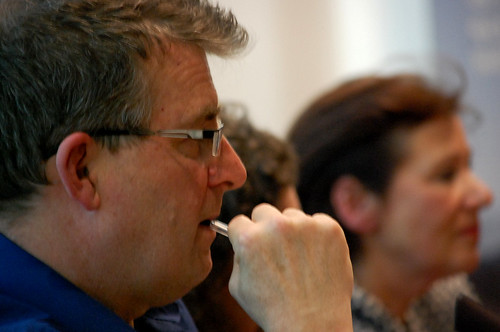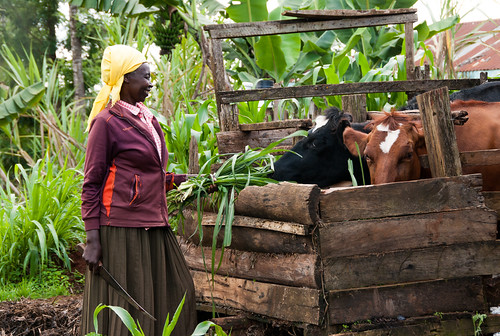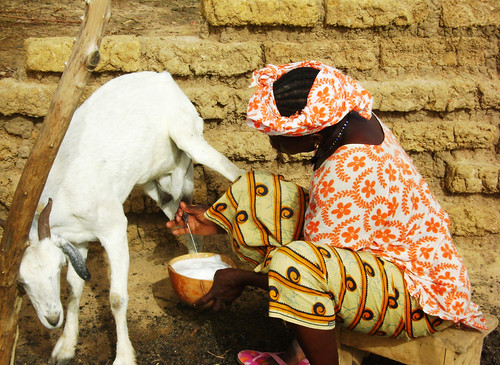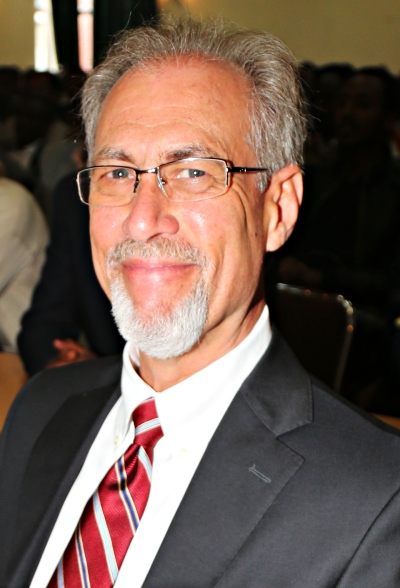![Tana River watershed, Kenya]()
Rachael Njeri has started growing forage strips on her farm in the Kenya’s Tana River watershed. The forage plants help prevent soil erosion and provide feed for her cattle (photo credit: CIAT/Georgina Smith).
The Committee on World Food Security (CFS) in Oct 2016 endorsed recommendations on Sustainable agricultural development for food security and nutrition: What roles for livestock?
The following policy recommendations build on the main findings of the CFS High Level Panel of Expert’s Jul 2016 report #10, on Sustainable agricultural development for food security and nutrition: What roles for livestock?
The sustainable development of agriculture, including livestock, is essential for poverty reduction and the achievement of food security and nutrition.
The recommendations aim to strengthen the contribution of the livestock sector to sustainable agricultural development for food security and nutrition and contribute to the progressive realization of the right to adequate food, in the overall context of achieving the 2030 Agenda for Sustainable Development, recognizing the essential role of smallholders in achieving food security and nutrition.
These recommendations draw upon the pathways towards sustainable livestock development identified by the HLPE report which are based on the three principles of improving resource efficiency, strengthening resilience and improving social equity/responsibility outcomes.
The Recommendations are primarily addressed to governments for public policies, but are also addressed to all stakeholders with a role in achieving food security and nutrition. The recommendations are voluntary and non-binding.
The recommendations aim to complement and not re-state recommendations and related guidance previously provided in other CFS products.
Recommendations
The recommendations listed below under ‘Part I: Sustainable Agricultural Development’ apply to all agricultural systems including livestock systems; specific references to livestock are coloured in burgundy. The specific recommendations listed under ‘Part II: Livestock Production Systems’ address particular challenges for the livestock sector. In the list below, both the burgundy highlights and the headings in ALL CAPS have been added to the original list of policy recommendations, found here.
Part I: Sustainable Agricultural Development
I. Foster policy coherence for food security and nutrition
a. INTEGRATED FOOD/AGRICULTURE/LIVESTOCK POLICIES
Promote integration of food security and nutrition into related policies to maximize the positive role that sustainable agricultural development and particularly livestock have in improving the economic, social and environmental sustainability of food systems, and strengthen coherence between sectoral policies and programmes.
b. GUIDANCE/AGREEMENTS/MULTI-STAKEHOLDERS
Build on guidance from relevant international and regional intergovernmental organizations and agreements, and take into account, as appropriate, the work of multi-stakeholder platforms and partnerships, which are dedicated to sustainable agricultural development and livestock specific issues.
c. FAIR AGRICULTURAL TRADE
Promote a fair and market-oriented world agricultural trading system in accordance with multilateral trade rules, in acknowledgment of the role of trade as an important element in support of sustainable agricultural development for food security and nutrition.
II. Address nutrition, food safety, working conditions and services
a. ANIMAL SOURCED FOOD FOR HEALTHY DIETS/NUTRITION
Encourage the appropriate intake of animal sourced foods, that is culturally acceptable, for healthy diets and improved nutrition, including through awareness-raising and education in the context of promoting sustainable agriculture and livestock production in accordance with SDG 12.
b. ANIMAL SOURCED FOOD FOR CHILDREN/WOMEN
Recognize the important role that animal sourced food, including dairy products, can play for children, pregnant and lactating women, and elderly people.
c. FOOD SAFETY/QUALITY
Develop capacity to meet national and international food safety and quality standards, frameworks, and schemes, ensuring that they are appropriate for different scales, contexts and modes of production and marketing, in particular CODEX Alimentarius standards.
d. WORKING/LIVING CONDITIONS
Ensure that the working and living conditions of all workers at all stages of production, transformation and distribution comply with ILO conventions, and are protected by domestic laws, and provide adequate living wages.
e. MARKET/CREDIT ACCESS
Develop and implement policies and tools to facilitate farmers’ access to markets and credit to help improve their livelihoods.
f. AGRICULTURAL INVESTMENT
Encourage responsible public and private investment, including foreign direct investment consistent with national regulations, and provide other forms of adequate financing, including official development assistance, that supports implementation of sustainable agricultural development, including livestock, particularly for smallholders, including those that are family farmers, and pastoralists.
g. AGRICULTURAL SERVICES
Facilitate inclusive access to quality social services, safety nets, extension, and breeding and veterinary services, particularly for smallholders, including those that are family farmers, and pastoralists.
III. Foster gender equality and women’s empowerment
a. RIGHTS OF WOMEN
Respect, protect and fulfil the rights of women working in agriculture, including the livestock sector.
b. WOMEN’S EMPOWERMENT
Promote gender equality and women’s empowerment, ensuring equal access to livestock productive resources, capacity building and education for women and foster women’s equal participation in decision-making.
IV. Foster empowerment of youth
a. YOUTH INITIATIVES
Promote youth initiatives, including education, training, rural advisory services and inclusive finance, to develop their capacity and facilitate access to land and resources, in order to enable them to be drivers of improvement in sustainable agriculture development, and involved in all levels of food systems.
V. Protect the environment and promote sustainable management and efficient use of natural resources
a. AGRICULTURAL SUSTAINABILITY
Promote sustainability and improvement of all systems of production, including organic approaches, agro-ecological approaches, and sustainable intensification, so as to preserve biodiversity and ecosystems, minimize environmental degradation and reduce greenhouse gas emissions per unit of product.
b. INTEGRATED AGRICULTURAL SYSTEMS
Promote integrated agricultural systems making better use of natural resources, halting deforestation, restoring degraded lands, improving soil quality, and fostering the sustainable management of water resources.
c. LIVESTOCK GENETIC RESOURCES
Strengthen the development, conservation, sustainable use and management of livestock genetic resources in line with the Global Plan of Action for Animal Genetic Resources, stressing the importance of the Domestic Animal Diversity Information System (DAD-IS), and promote access and benefit-sharing for animal genetic resources for food and agriculture, in line with relevant internationally agreed treaties.
d. TRADITIONAL/PASTORAL SYSTEMS
Recognize, respect and protect those traditional production systems, including pastoral systems and their mobility strategies, that use ecosystems sustainably and contribute significantly to the food security and nutrition of their communities and associated ways of life.
e. FOOD SYSTEM EFFICIENCIES
Identify options for improving efficiency throughout food systems, while minimizing negative environmental impacts and optimize the efficient use of energy, water, nitrogen and other natural resources.
f. FOOD LOSS/WASTE
Reduce food loss and waste including by supporting the improvement of infrastructure and cold chain development, through consumer education, the dissemination of best practices, information, capacity development, and the transfer of technology as mutually agreed, including for smallholders and pastoralists, considering the most appropriate local technologies.
VI. Enhance resilience against risks and variability
a. TENURE RIGHTS
Strengthen the security of tenure rights in line with the CFS Voluntary Guidelines on the Responsible Governance of Tenure of Land, Fisheries and Forests in the Context of National Food Security, including in all cases of conflict.
b. CLIMATE CHANGE ADAPTATION/MITIGATION
Facilitate the adaptation to and mitigation of climate change in agricultural systems in line with the Paris Agreement, and with particular support for smallholders and pastoralists, and women’s role in food systems.
c. RISK MANAGEMENT
Develop policies and tools, and improve capacity, to assess, mitigate, and manage risks, and reduce excessive price volatility, and their impacts on the most vulnerable.
d. LIVESTOCK INSURANCE
Enhance access to livestock insurance for all systems, including index-based insurance.
e. DISEASE CONTROL
Improve disease prevention, control, and surveillance, including through cross border cooperation on transboundary diseases, in order to foster early-warning and early action on disease control, spread and eradication, with emphasis on the Peste des Petits Ruminants Global Eradication Programme.
VII. Promote cooperation and collaboration in innovation, research and development and address data needs
a. INTERNATIONAL COOPERATION
Enhance North-South, South-South and Triangular and international cooperation particularly for capacity building, transfer of technology as mutually agreed, sharing of knowledge, and to leverage additional financial resources.
b. RELEVANT/DISAGGREGATED DATA
Promote global collaboration for collection and dissemination of relevant and disaggregated data, especially by sex.
c. LIVESTOCK INNOVATIONS
Develop and foster innovation that addresses challenges in achieving sustainable agricultural development in livestock systems, including through collaborative and participatory research, transfer of knowledge and capacity building.
d. TRADITIONAL KNOWLEDGE
Support the protection and strengthening of traditional knowledge systems which promote sustainability and the use of experiential knowledge in research and development.
e. DIGITAL TECHNOLOGIES
Promote access to and the use of digital technologies, including for precision agriculture, and foster their appropriate application for sustainable agricultural development.
Part II: Livestock Production Systems
All Systems
VIII. Improve animal health and welfare
a. VETERINARY SERVICES
Enable access to veterinary and extension services, vaccinations, medications, including antimicrobials, adapted to the specific livestock production systems.
b. ANIMAL HEALTH
Improve animal health management including biosafety and biosecurity, particularly focusing on infectious diseases, zoonosis, and reducing exposure to environmental hazards, by following OIE (World Organization for Animal Health) standards, and the One Health approach.
c. ANTIMICROBIAL USE
In accordance with the UN General Assembly Political Declaration on Antimicrobial Resistance (AMR) (September/2016), the WHO7 Global Action Plan on AMR, FAO Resolution 4/2015, and OIE, CODEX Alimentarius and WHO guidelines and standards, in respect of the One Health approach and in the spirit of FAO, OIE, WHO collaboration, promote the prudent and responsible use of antimicrobials in agriculture and prevent their unnecessary use, including the phasing out of use of antibiotics for animal growth promotion in the absence of risk analysis.
d. ANIMAL WELFARE
Improve animal welfare delivering on the five freedoms and related OIE standards and principles, including through capacity building programmes, and supporting voluntary actions in the livestock sector to improve animal welfare.
e. ANIMAL FEED
Promote access to good quality feed, and facilitate training on sustainable feeding practices.
Specific Systems
IX. Recognize, protect and support pastoral systems for livelihoods and sustainable resource management
a. PASTORAL SYSTEMS
Enhance the effectiveness, sustainability, and resilience of pastoral systems for food security and nutrition.
b. PASTORAL MOBILITY/GOVERNANCE
Enable pastoralists’ mobility, including transboundary passage as appropriate; securing access to land, water, markets and services, adaptive land management, and facilitate responsible governance of common resources, in accordance with national and international laws.
c. PASTORAL ORGANIZATIONS/POLICIES/INVESTMENTS
Enhance the role of pastoralist organizations and strengthen public policies and investments for the provision of services adapted to the needs and ways of life of pastoralists and their mobility, including promoting gender equality and addressing the specific needs and roles of women within pastoralist communities.
X. Promote and support sustainable grazing systems
a. ECOSYSTEM SERVICES
Enhance the role of grazing systems in the provision of ecosystem services, including carbon storage, by improving the sustainable management of biodiversity, soil and water.
b. GRAZING MANAGEMENT
Restore degraded land and reduce deforestation by promoting sustainable grazing management, such as agro-silvopastoral systems, aiming at improved soil quality, carbon storage, pasture productivity, and conservation and storage of forages.
XI. Promote and support mixed systems
a. CROP-LIVESTOCK INTEGRATION
Strengthen integration of livestock with crops, including by more integration of legumes in crop rotation and inter-cropping, and forests-agro-silvopastoral systems—at different scales, including on farm, across watersheds and ecosystems, and provide benefits in terms of addressing input and energy needs in a sustainable manner, including through the use of draught power and the use of manure as fertilizer.
b. SUSTAINABLE LIVELIHOODS
Leverage the potential of livestock as a means for sustainable livelihoods for smallholders, through enabling collective organizations and actions, investing in infrastructure, facilitating access to markets, and implementing measures to manage risks and address challenges.
c. MANURE/WASTE MANAGEMENT
Promote manure management and the use of by-products and re-use and recycling of waste, as appropriate, while protecting water and air quality, and improving soil health.
XII. Promote the sustainability of intensive systems
a. FEED PRODUCTION/USE
Reduce pressure on resources by promoting the efficiency of feed crop production and feed use and the sustainable use of appropriate by-products for feed.
b. PRODUCTION EFFICIENCY/ENVIRONMENTAL PROTECTION
Improve production efficiency and protect the environment, including by improving the management of waste and the use of by-products, and through the use and sharing of innovative and appropriate technologies and practices.
c. WORKING/LIVING CONDITIONS
Ensure that working and living conditions meet national and internationally agreed labour standards and reduce occupational hazards and other harmful effects on workers across the value chain.
d. ANIMAL WELFARE
Promote a physical environment and genetic selection that ensures compliance with the OIE welfare standards, including the Five Freedoms.
About the Committee on World Food Security (CFS)
CFS is the foremost inclusive international and intergovernmental platform for all stakeholders to work together in a coordinated way to ensure food security and nutrition for all. CFS endorses policy recommendations on a wide range of food security and nutrition topics.
CFS is the foremost inclusive international and intergovernmental platform for all stakeholders to work together to ensure food security and nutrition for all. The Committee reports to the UN General Assembly through the Economic and Social Council (ECOSOC) and to FAO Conference.
Using a multi-stakeholder, inclusive approach, CFS develops and endorses policy recommendations and guidance on a wide range of food security and nutrition topics. These are developed starting from scientific and evidence-based reports produced by the High Level Panel of Experts on Food Security and Nutrition (HLPE) and/or through work supported technically by The Food and Agricultural Organization (FAO), The International Fund for Agricultural Development (IFAD), World Food Programme (WFP) and representatives of theCFS Advisory Group. CFS holds an annual Plenary session every October in FAO, Rome.
About the High-Level Panel of Experts on Food Security and Nutrition (HLPE)
The High Level Panel of Experts on Food Security and Nutrition (HLPE) was established in 2010 as the science-policy interface of the UN Committee on World Food Security (CFS). The HLPE aims to improve the robustness of policy making by providing independent, evidence-based analysis and advice at the request of CFS.
About ILRI’s involvement in the CFS report on livestock
The ten HPLE project team members who prepared the CFS Report #10 on sustainable agricultural development for food security and nutrition, including the role of livestock, which was presented at the 43rd CFS Plenary Session in Oct 2016, was led by Wilfred Legg (UK), an agricultural economist, and included among its team members Delia Grace (Ireland), a veterinary epidemiologist and zoonotic disease and food safety expert leading a research program at the International Livestock Research Institute (ILRI) and two flagships of the CGIAR Research Program on Agriculture for Nutrition and Health (A4NH), led by the International Food Policy Research Institute (IFPRI). In addition to Grace, the other team members included Khaled Abbas (Algeria), Daniela Alfaro (Uruguay), Botir Dosov (Uzbekistan), Neil Fraser (New Zealand) Robert Habib (France), Claudia Job Schmitt (Brazil), Langa Simela (Zimbabwe) and Funing Zhong (China).
![]()
![]()

